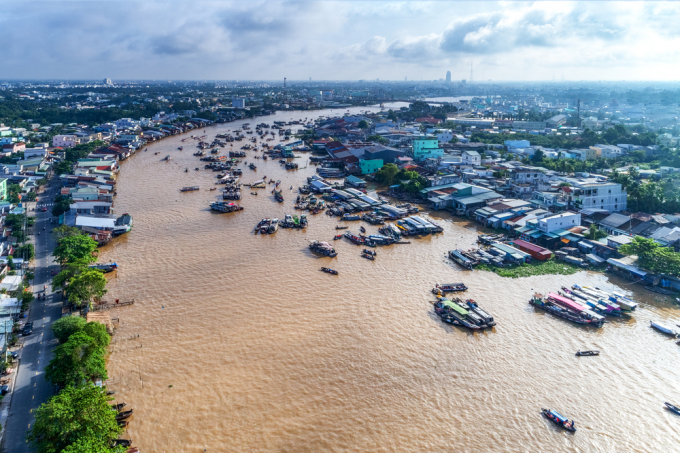Tran De port set to become gateway seaport to Mekong Delta
HCMC – Tran De port in Soc Trang Province is set to become a gateway seaport to the Mekong Delta, according
Irrigation in the Mekong Delta is currently facing three major challenges: Changes in exploitation from upstream, impacts from the sea, and the development problem within the Mekong Delta itself. Photo: Hoang Nam.
On the Planning for the Mekong Delta in the 2021 - 2030 period, with a vision to 2050, the resolution unifies the viewpoints, development goals and development orientations of major sectors and fields of the delta region.
The timely approval of the Planning for the Mekong Delta in the 2021 - 2030 period, with a vision to 2050 is an urgent requirement to create favorable conditions for the provinces and cities in the Mekong Delta to organize the provincial plannings for the 2021 - 2030 period, ensuring the linkage, synchronization, inheritance, stability and systematicity among the plans.
By 2030, the Mekong Delta will be developed as a sustainable, dynamic and highly efficient agricultural economic center of the country, region and the world on the basis of developing a system of focal centers on agriculture, economic corridors and dynamic cities with diversified services and industries, high technology application with synchronous infrastructure system, adapting to climate change.
The Mekong Delta will also be developed as a marine economy with strengthened intra-regional, domestic and international connections; development of science, technology and innovation; improvement of the quality of human resources; creating a sustainable living environment, good quality of life for local people in association with the conservation of important resources and ecosystems; maintaining and embellishing the unique and diverse cultural identities of ethnic groups.
At the same time, there will have a continuous priorities for the development of essential infrastructure, including transport, energy, clean water supply, a focal center for agriculture, education - training, health care, irrigation, natural disaster prevention and control, adaptation to climate change.
The resolution clearly states the acceptance of loans, selection of criterias and listing of investment projects, the financial mechanism of the projects and relevant contents are implemented in accordance with the law.
The MARD is now managing 5 projects in the Mekong Delta, of which 3 projects getting loans from WB. Photo: TL.
At the Mekong Connect 2021 held recently, Minister of Agriculture and Rural Development Le Minh Hoan said, according to some experts, thirteen provinces and cities in the Mekong Delta are not economic entities but thirteen fragments, thirteen separate administrative boundaries combined into a delta of 20 million people.
“Economic blood vessels” are scattered throughout these areas. For example, pangasius and fingerlings are produced in Long An but processing factories are located in Can Tho, and one must go through the gateway of Ho Chi Minh city to reach the consumming market.
“The Mekong Delta must be seen as one unified economic entity,” said Minister Hoan.
According to the International Cooperation Department (the Ministry of Agriculture and Rural Development - MARD), in the period of 2021 - 2025, localities in the Mekong Delta are preparing the loan proposal for 5 ODA projects, in which the irrigation sector has the project “Strengthening and integrating land and water infrastructure for development and livelihood transformation in the Mekong Delta”.
In the agriculture sector, there are two projects, including the project “Developing smart agricultural value chains to adapt to climate change” with loans from WB, and the project “Developing essential infrastructure, supporting agricultural transformation to adapt to climate change in the Mekong Delta” with loans from the Asian Development Bank (ADB).
In the fisheries sector, there is a WB loan project named "Sustainable fisheries development" with the participation of 4 provinces in the Mekong Delta.
In the forestry sector, there is a project "Restore and sustainably manage protection for forests in coastal provinces in the Mekong Delta".
“The MARD is now managing 5 projects in the Mekong Delta, of which 3 projects getting loans from WB, and the last 2 projects getting loans from ADB,” said recently Deputy Minister of the MARD, Mr. Nguyen Hoang Hiep.
Those projects cover fields such as irrigation, agriculture, fisheries, forestry.
There is another resource from the Ministry of Planning and Investment with loan of US$ 2 billion mostly from WB, but it has not been disbursed due to the uncertain situation to define the central government or provinces to apply for the loan. As planned, the loan is spent to invest in infrastructure, essential constructions for the Mekong Delta with the irrigation in mind.
The Ministry of Construction is also preparing to propose investment projects on clean water supply for the Mekong Delta region...
Deputy Minister Nguyen Hoang Hiep says he has worries that the Mekong Delta currently implements too many investment projects, too many projects, not too much money. While the Mekong Delta needs to ensure regional connectivity, tearing the projects apart might be counterproductive. “If the Coordinating Council for the Mekong Delta participates more and more, the effect will be very high,” said Deputy Minister Hiep.
“We borrow not to spend but have to achieve the best efficiency. It is a must to determine the effectiveness before implementing,” he emphasized.
Translated by Khanh Linh

